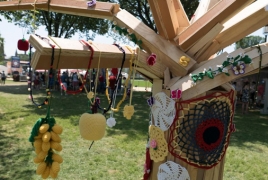
Smithsonian has prepared an article about Armenia’s "tree of life" tradition, in which the magazine says that the country's engagement with the tree of life motif runs especially deep, dating back to unrecorded time prior to the dawn of Christianity.
As Armenian symbolic anthropologist Levon Abrahamian explains, sigils on ancient figurines illustrate that people from the region revered the image of the tree long before the crystallization of a coherent Armenian national identity.
Even humble kitchenware speaks to the enduring importance of the tree of life in the Armenian household. “Vessels used in the kitchen for keeping oil or other products often have a primitive tree design, symbolizing life-giving properties of the vessel,” Abrahamian says. The iconography “can be traced back as far as Armenian culture can be identified,” he asserts—“some three thousand years.”
As Christianity took hold in Armenia in the early years of the fourth century A.D.—making it the first nation to declare the young religion its official faith—the tree of life symbol evolved alongside the rest of the culture. It became intimately connected with the Christian view of human fulfillment, an exemplar of the growth and enrichment that brought one and one’s family closer to the Lord.
Not surprisingly, depictions of the tree of life can be found on the grounds of many of Armenia’s historic medieval monasteries—often in the context of khachkars, ornate crosses etched by hand in stone steles. “The Tree of Life motif frequently appears on khachkars in the form of sprouting, bursting, blooming and fruit-bearing crosses,” Abrahamian writes, and “its presence on gravestones anticipates the resurrection of those who have passed away.”
Living trees in the churchyard have also come to take on spiritual significance. “People hang pieces of their clothes or the clothes of sick relatives on the branches,” says Abrahamian, “anticipating health or curing for the people to whom those clothes belonged.” Some sacred trees in Armenia are conceptualized more broadly as “trees of wishes,” where anyone may express a sincere wish and leave a token of themselves behind.
At this year’s Smithsonian Folklife Festival, which concluded this past weekend, organizers blended the tree of life tradition with Armenia’s rich background in the art of crochet, inviting visitors to learn crochet techniques, create personalized designs, and attach them to the limbs of a wooden tree-like scaffold in a figurative and literal coming-together. This activity was made possible by donations from the Armenia Tree Project.
Like all trees of life, the Smithsonian’s humble tree has grown more and more bountiful with each day. Swathed in a handmade coat of many colors, the tree that began as a naked sculpture of wooden planks is now a living testament to the vibrancy of Armenian tradition. “It was a very simple idea,” Butvin says, “but beautifully became something much larger.”

